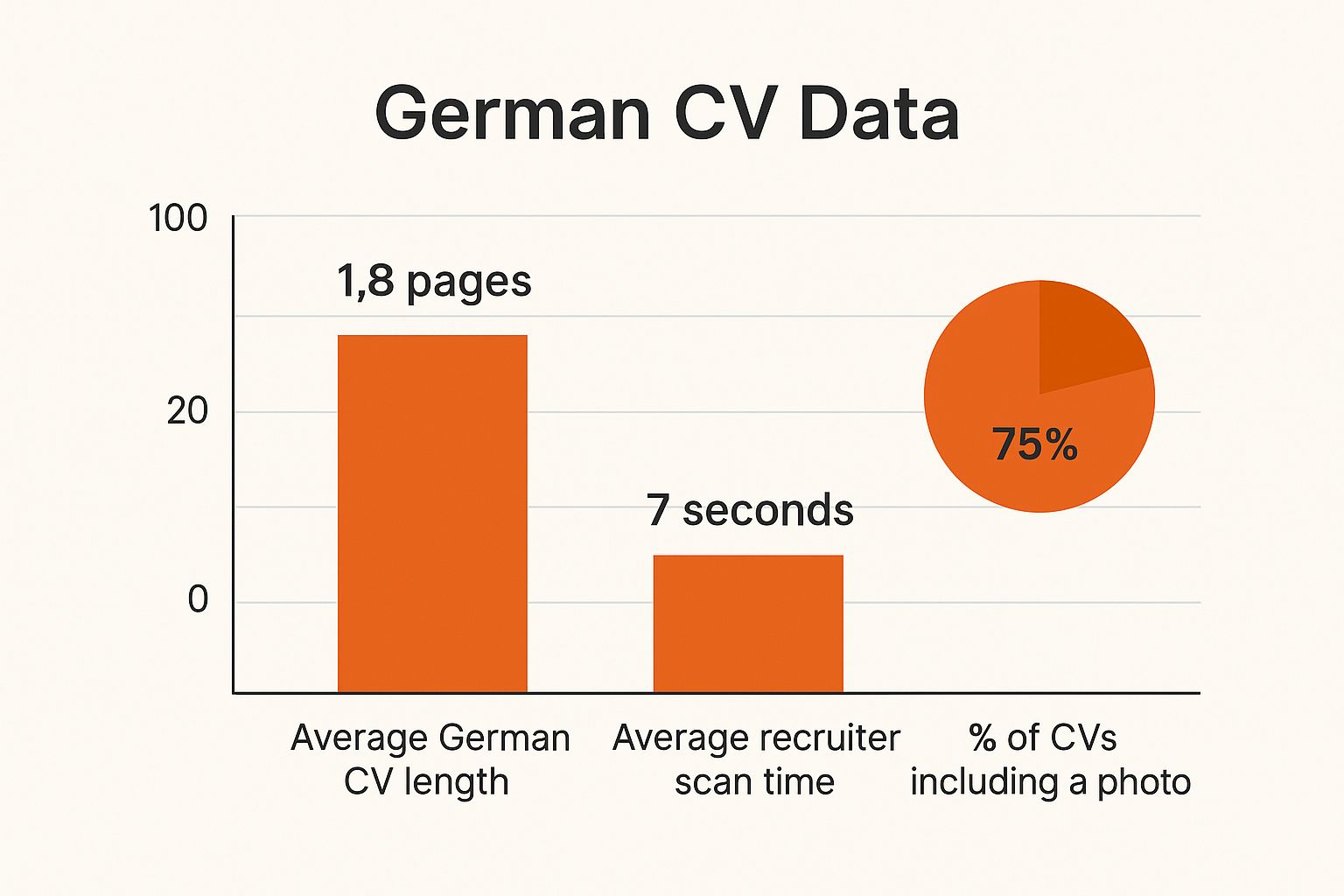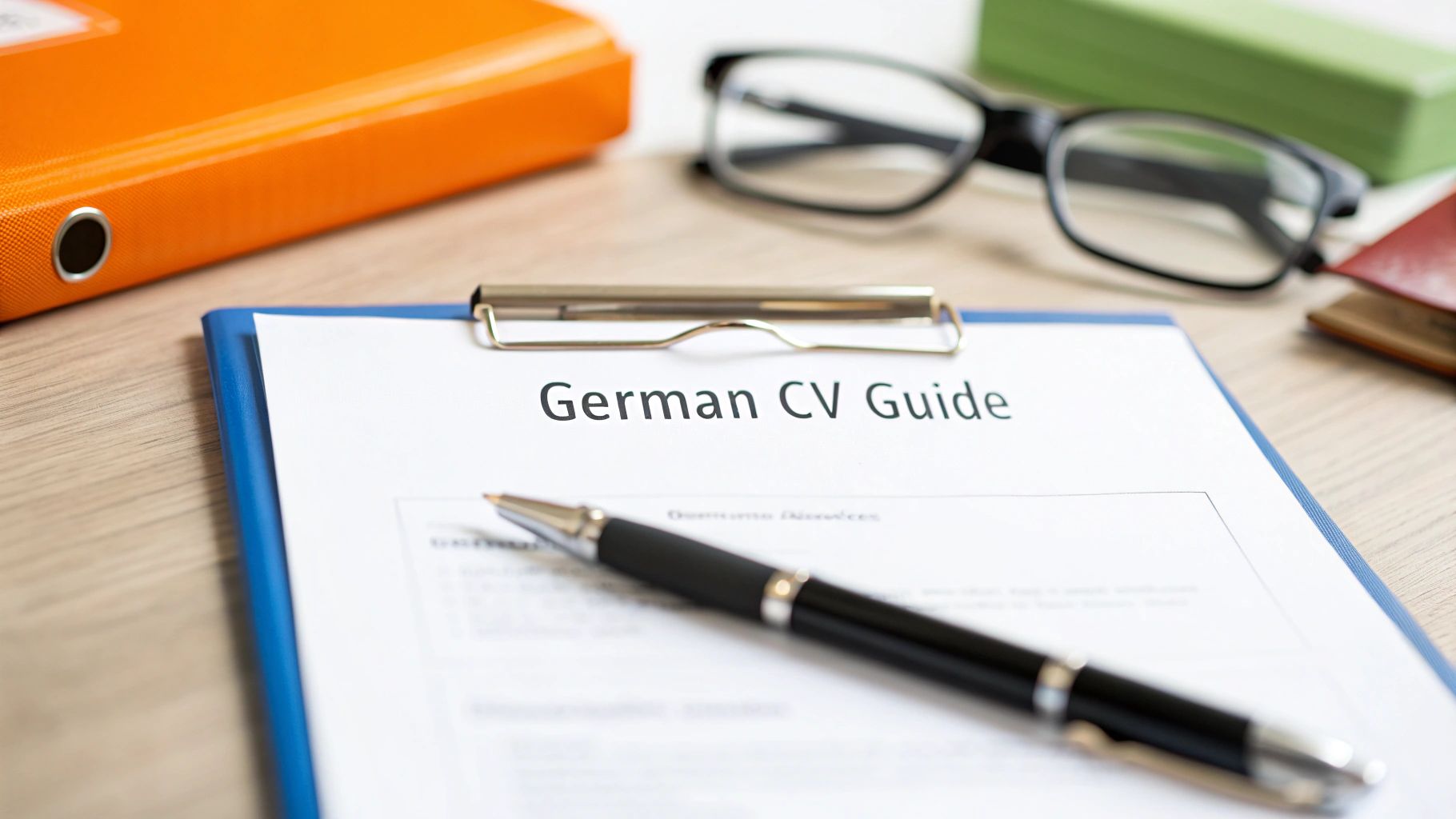If you're aiming for a job in Germany, the first thing you need to get right is your CV, or Lebenslauf. It’s a very particular kind of document—far more structured and factual than what you might be used to. Think of it less as a marketing brochure and more as a precise, data-rich summary of your professional life.
The whole point is to give a recruiter a crystal-clear overview of your qualifications at a glance. We’re talking a document that’s typically one to two pages long, designed for maximum efficiency.
Cracking the Code of the German Lebenslauf
Before you even start typing, it's crucial to understand the philosophy behind the German CV. It isn't the place for storytelling or flowery language. Instead, it’s a chronological, almost clinical, report of your career. German recruiters are trained to scan for specific information in a set format, and veering from that can be a red flag.
This means every single detail counts. You need absolute precision with your dates, job titles, and educational background. Your goal is to present a complete, gap-free timeline that showcases your reliability and meticulous nature—two qualities held in very high regard in the German workplace.
What German Recruiters Really Want to See
When a German hiring manager picks up your CV, they expect to see a document that’s logical, immaculately organised, and incredibly easy to read. The traditional layout has clearly defined sections for personal details, work experience, education, and skills. This isn’t just a stylistic preference; it’s a professional standard. Following it shows you've done your homework and understand local business culture.
This infographic gives you a quick snapshot of what to expect, based on real data.

As you can see, brevity is key, but things like including a professional photo are still very common. And that initial scan? It's over in seconds.
A well-crafted Lebenslauf is your first professional handshake in Germany. It tells them more than just what you’ve done—it shows you respect their business etiquette and can present information clearly and factually.
German CV vs International Resume at a Glance
To put it all into perspective, let's quickly compare the German Lebenslauf with a more typical international or US-style resume. The differences are subtle but incredibly important for making the right first impression.
| Feature | German CV (Lebenslauf) | International Resume |
|---|---|---|
| Length | Strictly 1-2 pages (3 for very senior roles) | Can be more flexible, often 1 page |
| Photo | Traditionally included, professional headshot | Generally omitted to avoid bias |
| Personal Info | Often includes date/place of birth, nationality | Name and contact details only |
| Structure | Reverse-chronological, tabular format | Varies, can be skills-based or chronological |
| Tone | Factual, objective, and formal | More marketing-oriented, uses action verbs |
| Signature | Traditionally signed with date and location | Not signed |
| Career Gaps | Must be explained | Often glossed over or omitted |
This table makes it clear: the Lebenslauf is a comprehensive, factual record, while an international resume is more of a selective marketing tool. Approaching your German application with this distinction in mind is the first step toward success.
Getting the Format Right: Core Components
A standard German CV demands meticulous attention to detail, right down to your font choice. The entire document is built for clarity, helping recruiters quickly assess your profile without any fuss. Essential sections like Personal Information, Professional Experience, and Education are absolutely non-negotiable.
Even the small things matter. Stick to conservative fonts like Times New Roman or Arial. Keep your main body text around 11 points and your main headings a bit larger, maybe up to 16 points, for readability. Above all, be consistent. Using unusual fonts or a messy layout can make your CV look unprofessional and difficult to read, potentially getting it dismissed before a recruiter even gets to your experience.
If you want to be sure your CV hits all the right notes, getting a second opinion from someone who knows the market is a great idea. You can find German industry experts who offer personalised feedback on platforms like https://www.iknowly.com. This can be invaluable for ensuring your application is perfectly aligned with what local employers are looking for.
Crafting Your Personal Information Section

The first part of your CV, often labelled Persönliche Daten, is where you'll immediately notice some key differences in German professional norms. For many people coming from outside Germany, the amount of personal detail expected can be a bit of a culture shock. It goes well beyond just your name and phone number; it’s a formal snapshot of who you are, rooted in traditional German business etiquette.
This section always sits right at the top of your CV. Getting it right is crucial because it sets a professional, meticulous tone for everything that follows.
Required Personal Details
Let's start with the absolute essentials. Your Lebenslauf must contain this core information so a recruiter can clearly identify and get in touch with you. Think of these as the non-negotiable building blocks.
- Full Name (Vor- und Nachname): Your complete first and last name, no nicknames.
- Full Address (Anschrift): Your current street, postal code, and city.
- Phone Number (Telefonnummer): A reliable number where you can actually be reached.
- Email Address (E-Mail): Make sure it's a professional-looking email. The standard
firstname.lastname@provider.comformat is always a safe bet.
Now, here’s where things get more specific to Germany. You'll often see space for your date of birth, birthplace, and even your nationality. This might feel intrusive, but it's a holdover from a time when these details were directly linked to employment laws and work permits. That history has created a standard that is still very much alive today.
The Great Photo Debate
The professional photo, or Bewerbungsfoto, is probably the most debated part of a modern German CV. While it's no longer a legal requirement, leaving it out can sometimes be a gamble, especially in more conservative fields.
The General Act on Equal Treatment (AGG) of 2006 made it illegal for employers to demand a photo, aiming to stamp out discrimination. But cultural habits die hard. A high-quality, professional headshot is still extremely common and, in many cases, implicitly expected.
So, what’s the verdict? It really depends on the context. If you're applying to a tech startup or a big international company, you can probably get away with omitting it. But for jobs in traditional sectors—think manufacturing, banking, or the public sector—including a photo is the safer, and smarter, move.
If you decide to include one, it must be professional. We're talking about a picture taken specifically for this purpose, with a neutral background, business attire, and a friendly yet confident expression. A cropped selfie from your last holiday just won't cut it.
The German CV is a fascinating document, blending long-standing cultural traditions with evolving legal standards. It began as a highly structured way to log essential data for employment, and while it has modernised, you can still feel the influence of its past in today's hiring practices. To get a deeper sense of these roots, it's worth reading up on the development of the German Lebenslauf.
Presenting Your Career and Education History

This is where you make your case. The two most scrutinised sections of your German Lebenslauf are your Berufserfahrung (Work Experience) and Ausbildung (Education). Think of them less as a simple list and more as a carefully constructed story that proves you’re the right person for the job.
German recruiters have a strong preference for information presented in reverse chronological order. It’s a non-negotiable standard. Starting with your most recent role or degree shows them what you're doing now and how relevant your skills are today. It’s a sign of professionalism and shows you respect their time by making your career path easy to follow.
Structuring Your Work Experience
In the Berufserfahrung section, your goal is absolute clarity. You want a recruiter to grasp the essentials of each role in a matter of seconds.
Always begin with your current or most recent position and work your way back. For every job you list, make sure you include:
- Your official job title and the full legal name of the company, plus its city.
- The dates you were employed, sticking to the MM/YYYY – MM/YYYY format (e.g., "08/2021 – Present").
Now for the most important part: the bullet points. This is your chance to shine by detailing your achievements, not just your daily tasks.
So many people fall into the trap of just copying their old job description. German recruiters aren’t interested in what you were supposed to do; they want to see the actual, tangible results you delivered. They are incredibly data-driven.
Let’s put this into practice. A line like "Responsible for managing social media channels" is passive and tells them nothing. Instead, turn it into a powerful, quantifiable achievement: "Boosted organic social media engagement by 35% in six months after launching a new content strategy." See the difference? That’s the kind of impactful language that gets attention.
Example Work Experience Entry
Senior Marketing Manager
Musterfirma GmbH, Berlin
08/2021 – Present
- Drove €500,000 in new revenue within the first year by developing and executing a new digital marketing campaign.
- Led a team of four junior marketers, increasing team productivity by 20% by implementing new, streamlined workflows.
- Cut customer acquisition costs by 15% through rigorous PPC ad optimisation and A/B testing on all landing pages.
Detailing Your Education
Your education history, labelled either Ausbildung or Studium, also follows the reverse chronological rule. Don’t underestimate this section. Formal qualifications carry significant weight in Germany, and employers see your education as the bedrock of your professional expertise.
For each entry, be precise and include these key details:
- The exact name of your qualification, such as "Master of Science in Computer Science".
- The full, official name of the university or institution, along with its location.
- Your dates of study in the MM/YYYY format.
- Your final grade (Note). This is crucial in Germany and often expected. State it clearly (e.g., Note: 1,7).
- Your thesis topic. This is optional, but I highly recommend including it if the topic is at all relevant to the role you're applying for. It adds another layer of expertise.
By laying out your career and education with this level of detail, your Lebenslauf immediately signals to German hiring managers that you're a serious, professional candidate who understands their business culture. It’s an easy win that sets you apart from the very beginning.
Highlighting Your Skills and Certifications
So far, we've covered your professional journey and education. Now we move to the Besondere Kenntnisse (Special Skills) section—a place where you can really set yourself apart. German employers value concrete evidence of your abilities, and this is your opportunity to provide it.
Think of this part of your CV as the proof behind your professional claims. It’s where you list your technical know-how, language abilities, and any other qualifications that make you the ideal candidate. In the German CV format, this isn't just an afterthought; it’s a crucial component that shows a deep commitment to your field.
How to Present Your Language Skills
In Germany, language proficiency is almost always a deciding factor. You need to be both honest and incredibly precise here. Vague terms like "conversational" won't cut it; German recruiters are looking for standardised, universally understood levels of fluency.
It's best to use the established German grading system to describe your language abilities. This brings immediate clarity.
- Grundkenntnisse (A1/A2): This is basic knowledge. You can handle simple, everyday interactions.
- Gut (B1/B2): You have a good command of the language and can navigate most situations, including discussions in your professional field.
- Fließend (C1): You're fluent. You can speak spontaneously and confidently, even about complex topics.
- Verhandlungssicher (C2): This means you're business fluent, capable of negotiating and handling demanding professional conversations with precision.
- Muttersprache: This is simply your native language.
Always start with your native language, then list the others in order of proficiency. This structured, logical presentation is exactly what German hiring managers expect to see.
Organising Your IT and Software Expertise
Your approach to listing IT skills should be just as methodical. A long, jumbled list of every software program you’ve ever touched is a classic mistake. It's overwhelming and makes it difficult for a recruiter to spot what truly matters.
Instead, group your skills under clear, logical subheadings. This allows a hiring manager to quickly scan and find the tools relevant to their open position.
A software developer, for example, could structure their skills this way:
IT-Kenntnisse
- Programming Languages: Python (Expert), Java (Advanced), C++ (Proficient)
- Databases: SQL (Expert), MongoDB (Advanced)
- Cloud Platforms: Amazon Web Services (AWS), Microsoft Azure
- Development Tools: Git, Docker, Jenkins
See how much clearer that is? It instantly communicates a well-organised technical profile.
Key Takeaway: How you present your skills is as important as the skills themselves. German employers see a well-organised list not just as a convenience, but as a reflection of a structured and professional mind-set—a highly valued trait in their work culture.
Proving Your Commitment with Certificates and Training
Finally, make sure you have a dedicated subsection for Zertifikate (Certificates) and Weiterbildung (Further Education). The concept of continuous learning is woven into the fabric of German professional life. Highlighting your commitment to it can give you a serious edge.
List any relevant certifications, workshops, or professional development courses you've taken. Be sure to include the certificate's official name, the institution that issued it, and the year it was completed.
This detail does more than just back up your expertise. It sends a powerful signal that you are proactive about your career growth—a quality that resonates deeply with German employers and adds the finishing touch to a compelling skills section.
You've put in the hard work, carefully detailing your experience, education, and skills. Now, it's time for the final polish. This last review is often what separates a merely good CV from a truly great one, ensuring your application meets the exacting professional standards of the German market. Don't let a small oversight at this final stage undermine everything you've done.
The Finishing Touches: Signature and Final Review
A classic, and often expected, element in a German CV is the signature. It might feel a bit formal or even old-fashioned, but it carries real weight. At the bottom of your Lebenslauf, add the city you're in, the current date, and then your signature. You can either sign a paper copy and scan it or use a clean, professional-looking digital signature.
This isn't just a formality; it acts as a personal verification that everything you've stated is true and current. It’s a subtle nod to German business etiquette that shows you’ve done your homework.
Your Pre-Submission Quality Check
Before that CV leaves your outbox, give it one last, thorough check. A single typo or a formatting glitch can be seen as a lack of attention to detail—a soft skill that German employers value immensely. Run through this quick checklist to catch some of the most common stumbles.
- Is your email address professional? Stick to a simple
firstname.lastname@provider.com. That old email from your university days might be fun, but it won't impress a recruiter. - Have you kept it to two pages? Brevity is key. Unless you're a senior executive with a long and storied career, your CV should never spill onto a third page. Two pages is the absolute maximum.
- Are there any typos or grammar mistakes? A spellchecker is a good start, but it won't catch everything. The best trick? Read your CV out loud. You'll be surprised what you find. Better yet, have a friend or colleague give it a once-over with fresh eyes.
Think of it from the recruiter's perspective. A CV riddled with errors suggests you might be careless in your work. In a competitive job market, that’s an easy reason for them to put your application aside.
How to Handle Gaps in Your CV
One thing that will immediately raise a German recruiter's eyebrow is an unexplained gap in your employment history—what they call Lücken im Lebenslauf. The preference is for a seamless, logical career progression, so any blank spots need to be addressed head-on.
The key here is honesty and proactive framing. Never just leave a period of time unaccounted for. Instead, give it a clear, positive label. This shows you're transparent and were still being productive, even if you weren't in a traditional job.
Here are a few ways to constructively frame those gaps:
- Professional Reorientation & Further Training: This is perfect if you were taking courses, earning a certification, or actively exploring a career change.
- Sabbatical for Travel & Language Acquisition: A planned break for personal development is a completely valid reason for a gap.
- Parental Leave (Elternzeit): This is a standard and respected reason for a career break in Germany.
- Job Seeking & Professional Development: A straightforward and honest way to describe a period of unemployment, showing you were actively looking for your next role.
For many professionals coming from abroad, getting these CV details right is just one part of the puzzle. The other is securing your legal right to work in the country. For a complete breakdown of that process, our guide to German work visa requirements covers all the essential steps.
By meticulously handling every detail—from the final proofread to how you explain your career path—you present the polished, professional image that will resonate with German employers.
German CV Frequently Asked Questions

When you’re trying to get every detail of your German CV just right, a few questions are bound to pop up. It’s completely normal. In my experience, it’s often these small, specific details that make the difference between a good application and a great one.
Let's clear up some of the most common uncertainties I hear from job seekers. Getting these right shows German recruiters you’ve done your homework and understand the local culture.
Do I Really Need a Photo on My CV for Germany?
This is a classic question. While German anti-discrimination law (the AGG) means you aren't legally required to include a photo, the reality on the ground is a bit different. For many traditional German companies, a photo is still very much the norm and is often expected. A professional, friendly headshot helps build a personal connection and can make your CV more memorable.
However, the tide is turning. For roles in large international corporations, tech companies, or startups, a photo is often seen as less critical and can be left out. My advice? Check out the company's vibe. Look at their team page on their website. If you're still unsure, including a high-quality, professional photo is usually the safer bet to meet those traditional expectations.
Should I Write My CV in German or English?
This one has a straightforward rule of thumb: always mirror the language of the job advertisement.
If the job posting is written in German, your entire application—CV and cover letter included—must be in German. No exceptions. Submitting in English would likely get your application dismissed immediately. Conversely, if the advert is in English, you should apply in English. This is common for roles in big multinational companies or tech startups where English is the day-to-day working language.
Following this simple rule shows you're attentive and can follow basic instructions—a trait highly valued in Germany.
How Do I Explain Employment Gaps on a German CV?
Ah, the dreaded Lücke im Lebenslauf (gap in the CV). German recruiters prize a seamless, chronological work history, so unexplained gaps can raise a red flag. The key here is transparency and framing it positively. You need to show you were using that time constructively.
Don't just leave a blank space or write 'unemployed'. You should provide a clear, honest, and brief description of what you were doing. This turns a potential weakness into a sign of thoughtful career management and honesty.
Here are a few real-world examples of how to frame those periods effectively:
- Professional Reorientation & Further Training in Project Management
- Sabbatical & World Travel for Language Acquisition
- Parental Leave (Elternzeit)
This approach gives the recruiter context and maintains the clean, chronological flow that's so crucial for a German CV. Honesty is always the best policy. Of course, a great CV is just one piece of the puzzle. To really succeed, it helps to understand the local professional culture, which is why you might find our insights on networking in Germany helpful.
Is Signing My German CV Really Necessary?
Yes, absolutely. This is a small but powerful detail. Adding the current date, city, and your handwritten signature to your Lebenslauf adds a final touch of authenticity. It acts as a personal verification, signalling that all the information is current and accurate.
For digital applications, you can simply insert a scanned image of your signature. If that's not possible, even a professional-looking cursive font will do the trick. It’s a custom that shows you respect German business etiquette.
Feeling more confident about your CV is a great first step. But what if you could get direct feedback from a professional working at a top German company? With iknowly, you can book a 1:1 video consultation with verified experts from firms like Siemens and BMW to perfect your application. Get personalised career advice and ensure your CV stands out for all the right reasons.

Leave a Reply